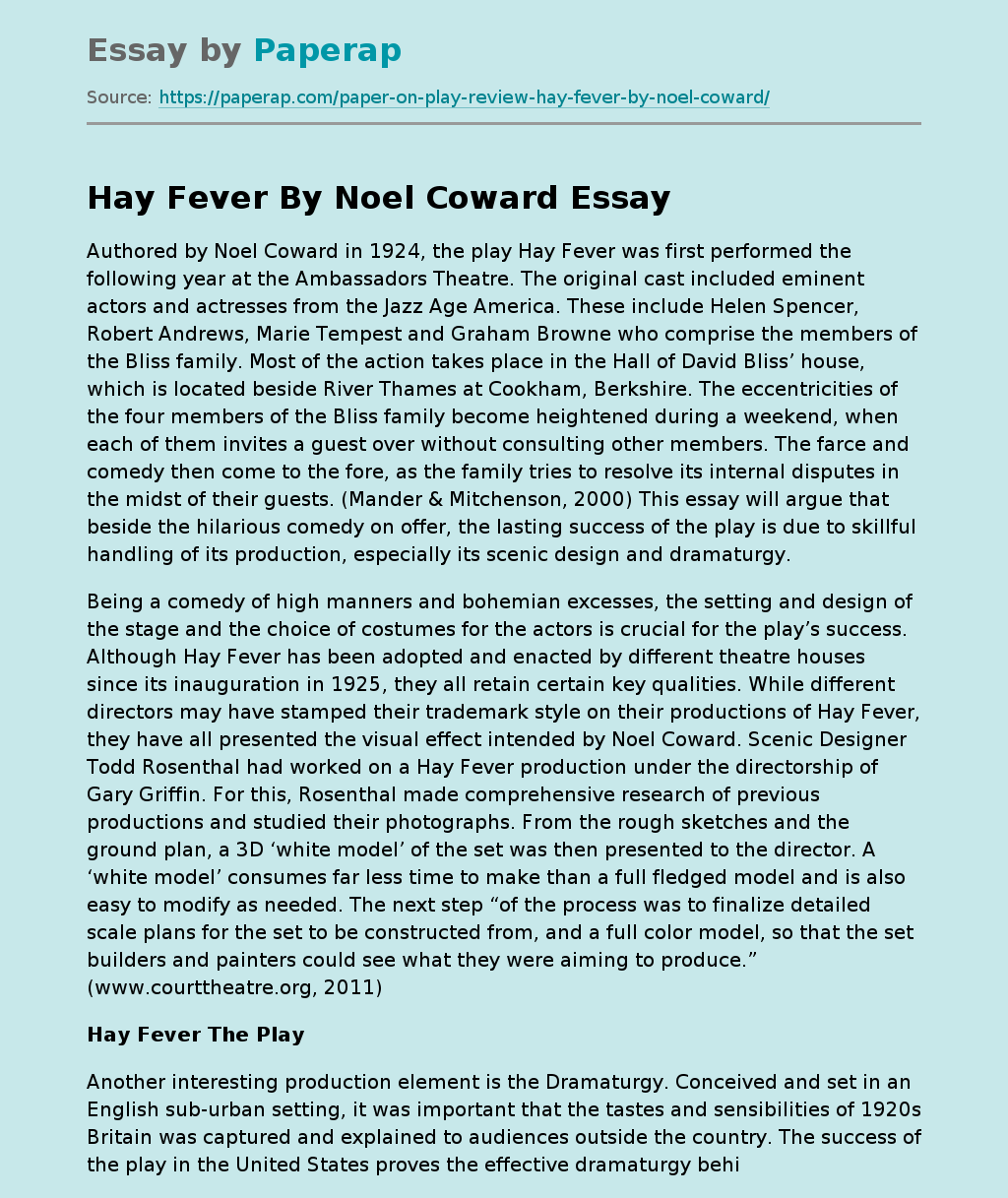Hay Fever By Noel Coward
Authored by Noel Coward in 1924, the play Hay Fever was first performed the following year at the Ambassadors Theatre. The original cast included eminent actors and actresses from the Jazz Age America. These include Helen Spencer, Robert Andrews, Marie Tempest and Graham Browne who comprise the members of the Bliss family. Most of the action takes place in the Hall of David Bliss’ house, which is located beside River Thames at Cookham, Berkshire. The eccentricities of the four members of the Bliss family become heightened during a weekend, when each of them invites a guest over without consulting other members.
The farce and comedy then come to the fore, as the family tries to resolve its internal disputes in the midst of their guests. (Mander & Mitchenson, 2000) This essay will argue that beside the hilarious comedy on offer, the lasting success of the play is due to skillful handling of its production, especially its scenic design and dramaturgy.
Being a comedy of high manners and bohemian excesses, the setting and design of the stage and the choice of costumes for the actors is crucial for the play’s success.
Although Hay Fever has been adopted and enacted by different theatre houses since its inauguration in 1925, they all retain certain key qualities. While different directors may have stamped their trademark style on their productions of Hay Fever, they have all presented the visual effect intended by Noel Coward. Scenic Designer Todd Rosenthal had worked on a Hay Fever production under the directorship of Gary Griffin.
For this, Rosenthal made comprehensive research of previous productions and studied their photographs. From the rough sketches and the ground plan, a 3D ‘white model’ of the set was then presented to the director. A ‘white model’ consumes far less time to make than a full fledged model and is also easy to modify as needed. The next step “of the process was to finalize detailed scale plans for the set to be constructed from, and a full color model, so that the set builders and painters could see what they were aiming to produce.” (www.courttheatre.org, 2011)
Hay Fever The Play
Another interesting production element is the Dramaturgy. Conceived and set in an English sub-urban setting, it was important that the tastes and sensibilities of 1920s Britain was captured and explained to audiences outside the country. The success of the play in the United States proves the effective dramaturgy behind its various adaptations. The Dramaturge is the person who interprets the play to the director and helps in the transition of the literary text into a performance artwork. In the various instances of the performance of Hay Fever, the role of the Dramaturge stands out. As a key member of the Creative team, “the Dramaturge is also responsible for editing the text of the play – comparing different editions and/or deciding on different translations. Finally, the Dramaturge is responsible for writing the program notes and any other articles about the play (including magazine articles) that will be distributed to the audience.” (www.courttheatre.org, 2011)
Hence, in conclusion, we see the importance of production elements such as Scenic Design and Dramaturgy behind the success of Hay Fever. The adept understanding of the essence of the play by Scenic Designers and Dramaturges is reflected in the enduring visual/intellectual appeal of the play nearly 90 years after its first production.
Works Cited:
Coward, Noel. Hay Fever. Heinemann, London, 1964. ISBN 0 435 20196 4
Mander, Raymond and Joe Mitchenson. Theatrical Companion to Coward. Updated by Barry Day and Sheridan Morley. Oberon 2000. ISBN 1-84002-054-7.
A Study Guide to Hay Fever, Court Theatre, retrieved from
on 16th October, 2011
Authored by Noel Coward in 1924, the play Hay Fever was first performed the following year at the Ambassadors Theatre. The original cast included eminent actors and actresses from the Jazz Age America. These include Helen Spencer, Robert Andrews, Marie Tempest and Graham Browne who comprise the members of the Bliss family. Most of the action takes place in the Hall of David Bliss’ house, which is located beside River Thames at Cookham, Berkshire. The eccentricities of the four members of the Bliss family become heightened during a weekend, when each of them invites a guest over without consulting other members. The farce and comedy then come to the fore, as the family tries to resolve its internal disputes in the midst of their guests. (Mander & Mitchenson, 2000) This essay will argue that beside the hilarious comedy on offer, the lasting success of the play is due to skillful handling of its production, especially its scenic design and .
Hay Fever By Noel Coward. (2019, Dec 05). Retrieved from https://paperap.com/paper-on-play-review-hay-fever-by-noel-coward/

